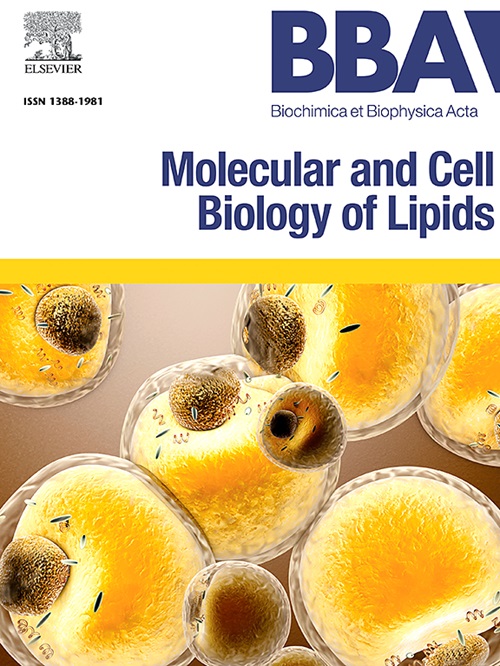PI(4,5)P2是Ca2+触发的囊泡胞吐的主要调节因子。
IF 3.3
2区 生物学
Q2 BIOCHEMISTRY & MOLECULAR BIOLOGY
Biochimica et biophysica acta. Molecular and cell biology of lipids
Pub Date : 2025-06-20
DOI:10.1016/j.bbalip.2025.159651
引用次数: 0
摘要
大量证据表明,磷脂酰肌醇(4,5)-二磷酸[PI(4,5)P2]是Ca2+依赖性囊泡胞吐所必需的质膜磷脂。Ca2+触发的囊泡胞分泌是一个组织良好的多步骤膜过程,包括囊泡对接、启动和可溶性n -乙基丙烯酰亚胺敏感因子附着蛋白受体(SNARE)依赖的融合。在神经内分泌细胞中,一组囊泡停靠在高浓度质膜PI(4,5)P2微域上,这些微域在Ca2+刺激下优先发生胞吐。PI(4,5)P2微结构域还通过静电相互作用介导质膜SNARE蛋白syntaxin-1和SNAP-25的分配和聚类。PI(4,5)P2招募并激活SNARE调节蛋白,如钙依赖性分泌激活蛋白(CAPS,又名CADPS)、哺乳动物不协调蛋白13 (Munc13)和突触tagmin-1,这些蛋白在囊泡胞外分泌的启动和融合步骤中起关键作用。在这篇综述中,我们讨论了PI(4,5)P2如何通过PI(4,5)P2结合效应蛋白控制囊泡胞吐的各个步骤。本文章由计算机程序翻译,如有差异,请以英文原文为准。
PI(4,5)P2 is a master regulator for Ca2+-triggered vesicle exocytosis
Substantial evidence indicates that phosphatidylinositol (4,5)-bisphosphate [PI(4,5)P2] is a plasma membrane phospholipid essential for Ca2+-dependent vesicle exocytosis. Ca2+-triggered vesicle exocytosis is a well-organized multiple-step membrane process including vesicle docking, priming, and soluble N-ethylmaleimide-sensitive factor attachment protein receptor (SNARE)-dependent fusion. A subset of vesicles are docked on high concentration plasma membrane PI(4,5)P2 microdomains that preferentially undergo exocytosis upon Ca2+-stimulation in neuroendocrine cells. PI(4,5)P2 microdomains also mediate plasma membrane SNARE proteins syntaxin-1 and SNAP-25 partitioning and clustering through electrostatic interactions. PI(4,5)P2 recruits and activates SNARE regulatory proteins such as calcium-dependent activator protein for secretion (CAPS, aka CADPS), mammalian uncoordinated-13 (Munc13), and synaptotagmin-1, which play pivotal roles in the priming and fusion steps of vesicle exocytosis. In this review, we discuss how PI(4,5)P2 controls each step of vesicle exocytosis through PI(4,5)P2-binding effector proteins.
求助全文
通过发布文献求助,成功后即可免费获取论文全文。
去求助
来源期刊
CiteScore
11.00
自引率
2.10%
发文量
109
审稿时长
53 days
期刊介绍:
BBA Molecular and Cell Biology of Lipids publishes papers on original research dealing with novel aspects of molecular genetics related to the lipidome, the biosynthesis of lipids, the role of lipids in cells and whole organisms, the regulation of lipid metabolism and function, and lipidomics in all organisms. Manuscripts should significantly advance the understanding of the molecular mechanisms underlying biological processes in which lipids are involved. Papers detailing novel methodology must report significant biochemical, molecular, or functional insight in the area of lipids.

 求助内容:
求助内容: 应助结果提醒方式:
应助结果提醒方式:


